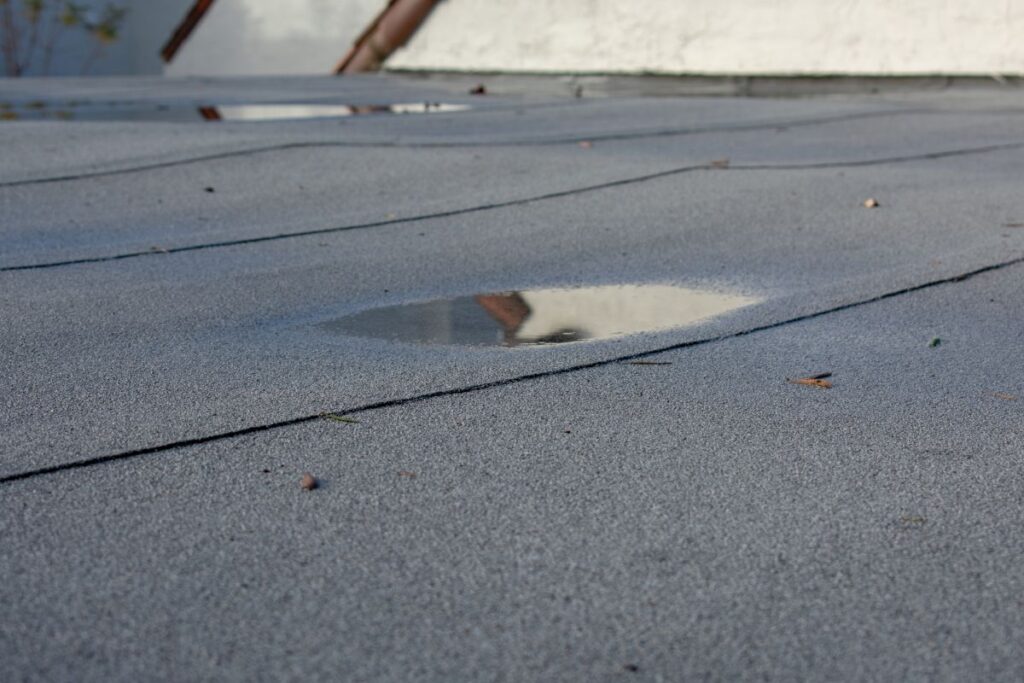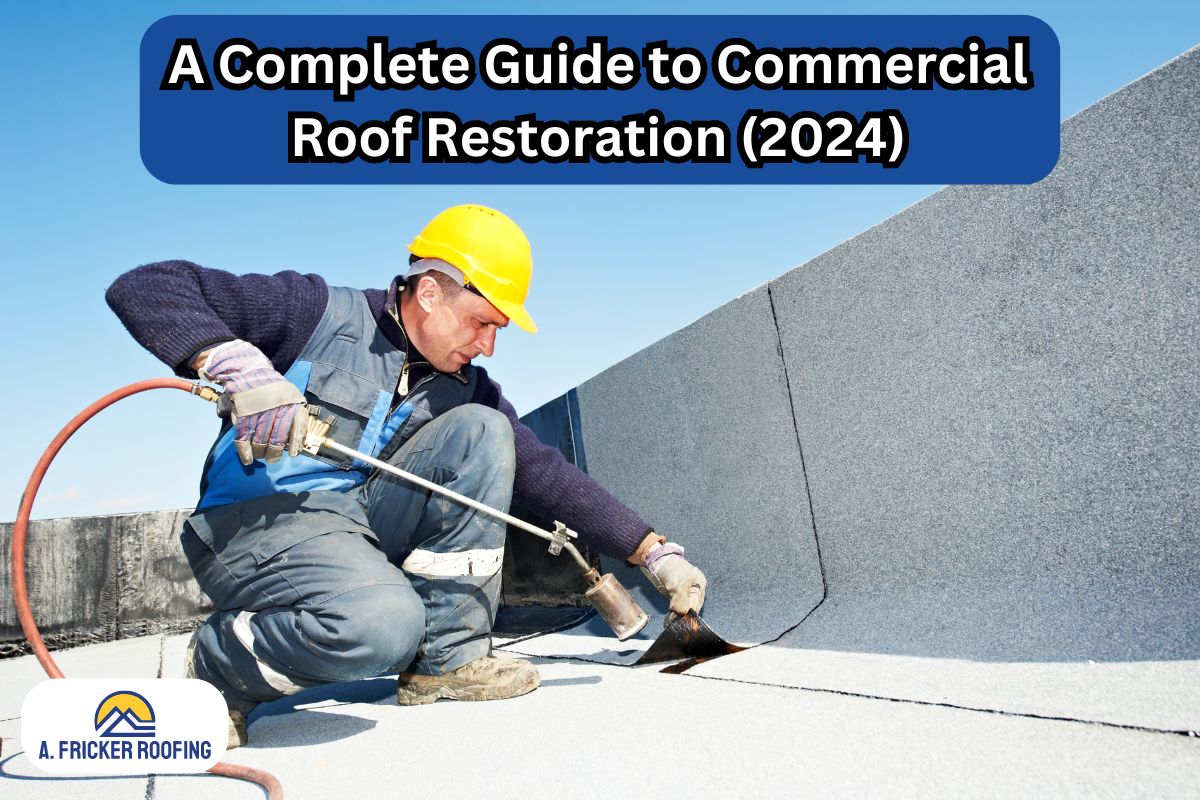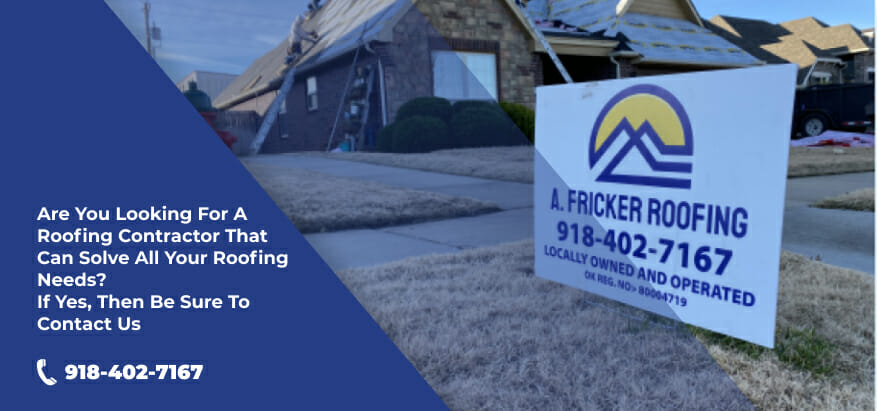Over time, all roofs inevitably start to show signs of wear and tear. Constant exposure to the Oklahoma weather—rain, UV rays, fluctuating temperatures, and even debris—takes its toll.
Commercial roofs, especially, can be even more vulnerable. Unlike residential roofs, which often have steep slopes that help water runoff, many commercial buildings are often designed with flat or low-slope roofs. This makes them more prone to issues like water pooling and leaks.
Although roof maintenance is crucial for the safety and longevity of a building, many business owners aren’t fully aware of an option called roof restoration. This is a way to give your roof a new lease on life, but it’s often overlooked.
As a premier roofing contractor offering commercial roof restoration services in Tulsa and surrounding areas, we are here to tell you all about restoring your roof so you can make an informed decision.
What is Commercial Roof Restoration?

Simply put, commercial roof restoration is a proactive approach to extending the lifespan of your roof. Instead of waiting for leaks to become too severe or damage to get out of hand, roofing restoration involves repairing, cleaning, and coating your roof to bring it back to like-new condition.
Many business owners may not even realize that roof restoration is an option for them. In fact, it’s a bit of an under-the-radar solution because most people immediately think they’ll need a full roof replacement when their roof starts to show signs of aging. But the reality is roof restoration is designed to fix existing issues while preventing future damage.
Think of it like a tune-up for your roof. The contractor will not completely remove the old system and instead will make changes to the existing roof so it lasts longer.
Roof Restoration vs. Roof Replacement
Now, you might be wondering, “Why not just replace the roof?” That’s a fair question, and the distinction between roof restoration and roof replacement is important.
Roof replacement involves tearing off the entire existing roof and installing a new one. This is a much bigger, more expensive, and more time-consuming project. It’s necessary when the roof is severely damaged, unsafe, or has reached the end of its useful life.
Roof restoration, on the other hand, is like giving your current roof a second wind. Instead of removing the existing material, you’re improving what’s already there. It can include several things, such as fixing minor damages, applying protective coatings, and preventing future issues. It’s less invasive, more affordable, and often just as effective for roofs that are still structurally sound but starting to show some wear.
In short, if your roof isn’t beyond repair, restoration is typically the better option.
What About Roof Repairs?
It might seem like restoration is the same as roof repairs, but these are very different services. Roof repairs mostly involve the treatment of a particular issue or a specific area of your roof, while restoration is a comprehensive solution that involves general maintenance for the entire system.
Types Of Roof Restoration
Metal Roofs: Metal roofs are strong, but over time they can develop rust or corrosion. Commercial metal roof restoration includes cleaning, rust removal, and the application of protective coatings that prevent further corrosion and reflect heat.
Membrane Roofs (EPDM, TPO, PVC): These types of roofing systems are made from synthetic materials and are popular for their flexibility and durability. Restoration for membrane roofs usually involves patching tears, resealing seams, and applying a reflective coating to extend the roof’s life.
Crucial Signs Your Commercial Roof Needs Restoration
So, how do you know when it’s time for a roof restoration? Here are a few telltale signs that you shouldn’t ignore:
Water Leaks:
One of the most obvious signs that your roof needs attention is leaks. Even small leaks can turn into major problems if left unchecked. If you see stains on the interior walls or ceilings, it is a sign that your roof is leaking.
Pooling Water:

Flat roofs are especially prone to water pooling in low areas. Most roofing materials are resistant to ponding water. But if it happens consistently, your roof is likely damaged.
Visible Damage:
Cracks, blistering, or peeling on the roof surface are signs that the roof membrane is deteriorating. This can make your roof less effective at protecting your building. If the cracks are in a specific location, roof repair is sufficient. But restoration can help if the problem is visible throughout.
Increased Energy Bills:
If your energy costs are creeping up, it could be due to poor insulation or ventilation in your roof. Restoring the roof can improve energy efficiency by sealing gaps and applying reflective coatings.
Aging Roof:
Most commercial roofs have a lifespan of 20 to 30 years, depending on the material. If your roof is approaching or surpassing this range, it’s time to start considering restoration, even if you haven’t noticed major damage yet. This can push your roof’s age by a few years.
It’s easy to overlook minor issues when they first appear, but catching them early is key to saving money and avoiding more significant disruptions down the road.
What Are The Benefits of Roof Restoration?
Roof restoration comes with major benefits, especially when compared to a full replacement. Let’s break down why restoration is often the smarter choice:
Cost Savings:
The most crucial benefit of roof restoration is the cost. It’s typically much cheaper than a full replacement because you’re not removing and rebuilding the entire roof. Restoring what’s already there can save you thousands in materials and labor. This can be extremely helpful when you are on a strict budget and want to delay the replacement.
Minimal Disruption To Your Business:
Complete roof replacements can take days or even weeks, and in that time, parts of your building might be inaccessible or your business might need to adjust its operations. Roof restoration, on the other hand, can often be done without interrupting your day-to-day activities. The work is quicker, less intrusive, and often doesn’t require you to close off the entire building.
Environmentally Friendly Approach:
By restoring your roof, you’re cutting down on waste that would otherwise end up in a landfill. Plus, many of the coatings and materials used in restoration are eco-friendly and improve your building’s energy efficiency, reducing your environmental footprint in the long run.
Extended Roof Lifespan:
Restoration extends the life of your roof by 10 to 15 years, sometimes longer. This buys you more time before you need to consider a full replacement, making it a great long-term investment.
Improves The Energy Efficiency Of Your Flat Roof:
Many roof restoration systems use reflective coatings that help reduce heat absorption. This can lower your cooling costs, making your building more energy-efficient and potentially saving you even more money over time.
The Roof Restoration Process
Here is what you can expect when you choose roof restoration services in Tulsa, OK.
Note: While the process may vary slightly depending on the type of roof and its condition, this section provides a general step-by-step breakdown.
Roof Inspection:
Every restoration project begins with a thorough roof inspection. Professional roofing contractors will assess the current condition of your roof, looking for any damage, weak spots, or areas that need repair.
Cleaning And Maintenance:
Next comes cleaning. Dirt, debris, mold, and old coatings are removed from the roof surface to create a clean base for restoration. This step is crucial because any lingering debris could interfere with the new coatings and repairs.
Roof Repairs:
After cleaning your roof, the experts will move on to repairs. Any existing damage, like cracks, leaks, or loose flashing, is repaired. These are vital to ensure the roof is structurally sound before moving forward.
Coating Application:
After repairs, a high-quality protective coating is applied across the entire roof surface. The type of coating will depend on the roof material, but it generally serves to protect the roof from future weather damage, UV rays, and water infiltration. The coating also helps improve the energy efficiency of the roof.
Final Inspection:
Once the coating has cured and everything is in place, a final inspection is conducted to ensure the roof is in top shape and ready to withstand future exposure to the elements.
Overall, this process can take anywhere from a day to a week, depending on the size of your roof and the extent of the repairs needed. However, most businesses can continue operations with little to no disruption during this time.
Start Your Project Today!
If you are looking for the most effective commercial roof restoration services in town, look no further than A. Fricker Roofing and Waterproofing. Our roofers are here to ensure that you get the best value for your money.
Don’t wait for small issues to become big ones—take action now to protect your building and your bottom line. Contact us today at (918) 402-7167 to get started.

